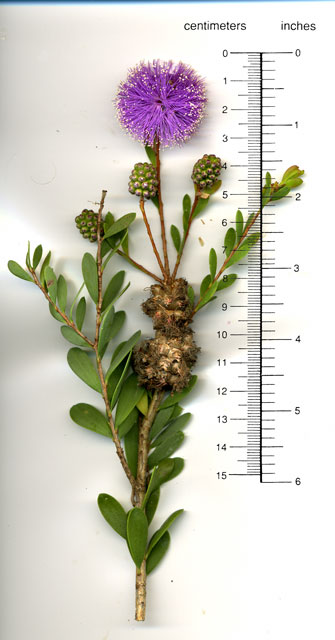Melaleuca nesophila
 showy honey myrtle
showy honey myrtle
Showy honey myrtle, from Doubtful Island, Western Australia, has beautiful mauve pincushion flowers surrounded by bright yellow anthers, the whole forming a ball about an inch in diameter suitable for cutting. After the flowers go, the seed capsules ripen in a smooth globular mass also about an inch long and remain on the stems for some time. The small oval leaves are a matte blue-green, about ½ by 1 inch, and clothe the plant to the ground in the early years. The arching stems and twigs are all covered with soft, multilayered, papery bark. The leaves, as with many members of the myrtle family, have a pleasant fragrance when crushed.
Specimens growing on Campus Drive East at Bonair Siding were cut back severely by the freeze of December 1972, when daytime temperature did not rise above 32° F. for three days. The large sheltered specimen in the northwest courtyard of Stern Hall was removed, its stump still visible in 2016.
Melaleuca leaves are a source of “tea-tree” oil, used for rheumatism and other disorders; it would be nice if the name tea tree was restricted to leptospermums, used by Captain Cook as a source of tea leaves, but many melaleucas are referred to in Australia as tea trees.
· Callistemon and Melaleuca: Key to Species.
Name derivation: Melaleuca – Greek mela (black) and leukos (white) because some species of the genus have black trunks with white branches; nesophila – island-loving.
About this Entry: The main text of this entry is from the book Trees of Stanford and Environs, by Ronald Bracewell, published 2005. Stern tree removal noted Jan 2018 (SP).




